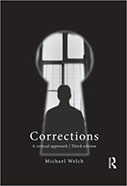Corrections: A Critical Approach. 3rd Ed.

Author: Michael Welch
Publisher: New York: Routledge, 2011. 768p.
Reviewer: Edward W. Sieh | May 2013
Michael Welch in Corrections: A Critical Approach 3rd ed. makes some very valuable contributions to our understanding of corrections. The work hopes to offer, and I believe it does so, a critical thinking exercise that draws attention to the comparative nature of corrections, work in the field of corrections, and cultural penology. The basic premise is that we cannot accept the correctional system on its face value because the system is too crowded, too violent, and too expensive to ignore, especially if there are alternatives that are equally effective.
Michael Welch makes use of various concepts in this work including the new penology, elements of historicism, radical criminology, economics, sociology of prisoners, women, juveniles and minorities, the critical correctional perspective, and institutional violence through state control and oppression. He also addresses the death penalty, jails, prisoner rights and correctional alternatives. Lastly, there is a discussion of correctional officers, privatization, and what is referred to as drug offenders and the war on terror.
The book opens with a discussion of the critical approach to the new penology by considering the huge cost of maintaining high prison populations when, at the same time, the crime rate is falling. This strategy enhances social control through the employment of risk assessment devices directed toward high-risk and dangerous groups, especially the underclass; it is thought best to control them in prison. This process effectively racializes punishment, establishes upper-class hegemony, and opens the door for the abuses of the privatized prison experience. This chapter ends with an imaginative and important discussion on cultural criminology and what is understood as penal spectatorship, as most clearly seen in penal tourism which is juxtaposed against Foucault’s model for surveillance.
Next, attention is given to the social history of punishment and prisons. Material is offered on ancient forms of punishment going back to the Code of Hammurabi followed by coverage of ancient Greece, Rome and the Middle Ages, as well as the Enlightenment as presented by Bentham and others. The author argues that the history of punishment can be understood as a response to the combined forces of politics, religion and technology. Furthermore, America’s penal past is examined by revisiting historical precedents. Then we are introduced to the radical reconceptualization of the offender, not as a moral degenerate, but as someone subject to societal influences, which necessitate moving him or her or to a “better place” –the prison.
The section on theoretical penology deals with various correctional themes. Its most interesting contribution is its analysis of radical penology as a social critique which attempts to refocus the debate on the forces of structural inequality associated with political, economic and racial disparities strongly associated with poverty and other social problems. Attention is given to the conflict, domination, and repression found in the correctional apparatus, the contradictions of the capitalist system, protection of the interests of the powerful, and the use of prison to manage the surplus labor force faced with unemployment and social control. These policies call for radical social change and greater accountability for white collar offenders.
The social world of prisons is populated by men but also women, juveniles, and minorities within a massive correctional enterprise. Various types of correctional institutions are discussed within the context of the prison power structure evident in a total institution, and the paramilitary or bureaucratic organization, and how inmates adapt to these conditions. The suggestion that viewing the prison as a total institution may not be quite valid anymore, then begs the question as to how we characterize inmate behavior other than as a form of secondary adjustment to the institution.
It is quite important to offer an incisive discussion of women in prison. Welch offers details on the number of women in prison, their characteristics, problems, criminal history, and the effects of patriarchy on women. This section on women in prison adequately covers the various theories of feminist criminology, but the discussion of Argentine positivism and the use of religious organizations in connection with their correctional policy is perplexing; one wonders whether this discussion is better suited in a book on comparative criminal justice systems. Later on Welch discusses programs for women, their social world, including the convict code, roles, social organization and prison families, material that is covered in comparable texts. There is an interesting section on women guards and the abuses that occur in women’s prisons. These issues are important from a human rights perspective.
The discussion of juvenile corrections begins with a detailed analysis of the juvenile justice system, the most relevant section being the institutional problems which include sexual victimization, the social world of juvenile institutions, the emphasis on the morality of the female offender, and the available alternatives.
The imprisonment rate for minorities is considered a reflection of a system whose outcomes, despite any claims to the contrary, are clearly discriminatory. Further discussion covers racial profiling, detention, and sentencing. There is an interesting discussion of minority offenders especially Latinos and Native Americans. There is also a discussion of prison gangs and penal violence. This is a useful section as it outlines various forms of violence and discusses the social climate leading to it, as well as the social processes of prison riots. Violence par excellence is discussed in the presentation on executions and especially wrongful executions. The discussion of the death penalty unfortunately does not include any discussion of the execution of the poor in this country regardless of race. The section on wrongful convictions lacks supporting data to make the point more forcefully. Furthermore, the Randall Adams case in the section on wrongful executions needs updating since it refers to David Harris as being in prison, whereas he was executed more than ten years ago.
The author’s discussion of jails proves interesting in that it draws attention to the problems of mass detention, especially of illegal immigrants and the locking-up of the underclass in general. Some of these problems are dealt with by implementing a strategy of new-generation jails. There is still the problem of who ends up there because of inadequate criminal defense — which leads to a discussion of prisoners’ rights.
Welch includes discussion of prisoners’ rights and addresses the importance of prisoner litigation. There is a very limited discussion of the history of prisoners’ rights with no attention given to the California Prisoners Union in the 1970’s, and there is certainly no mention of the unions that were organized in the United States and Scandinavian counties which went by the acronyms of KRIM, KROM and KRUM. These groups made important contributions to a world- wide effort to further prisoner rights. Since the author introduces international material this would seem relevant.
Attention instead is given to Texas and Arkansas and the Three Strikes laws. Various constitutional amendments including the First, Fourth, Eighth and Fourteenth are discussed, and Welch covers human rights violations associated with the internment of the Japanese, chain gangs, medical experimentation, cell extraction and political activism. Some discussion of the philosophical basis for why prisoners have rights would have added great value to the book. Do prisoners ultimately have rights as an expression of their human dignity? Rosen argues that Kant connected dignity with the idea of all human beings having unconditional, intrinsic value, and it is by reference to Kant that attempts have been made to turn the principle of respect for dignity into practical, moral and legal decisions.
In light of the central theme of this work, but acknowledging reviewer bias, it might have been appropriate to move the discussion of prisoners’ rights to the beginning of the book and give it the emphasis it deserves. One could offer a comparative analysis of the impact of making changes in the class structure or in promoting the human rights of prisoners. The former may prove impossible in today’s world, but the latter is possible only if mechanisms for the defense of these human rights are in place.
The book concludes with the obligatory discussion of correctional alternatives, correctional officers, privatization, the war on drugs, and the war on terror. Correctional alternatives are difficult to discuss because they are employed in vastly different ways; for example, Minnesota and Massachusetts have very different enterprises. The presentation on prison guards might have greater impact were it presented earlier, possibly before the discussion of prison violence where it can be folded into an understanding of guards and their use of violence. As to privatization, there is now a considerable body of literature suggesting the privatization movement has serious problems and may have run its course, as there are prison systems all over the country with declining prison populations. For example, New York State’s prison population has declined to the extent that it has three different prisons on the market. Many small communities have been stuck with oversold prison construction products and incredibly huge debts. Finally, the section dealing with the war on drugs might be retitled, inasmuch as there is discussion of various health issues including mental illness, aging, tuberculosis, and suicides.
The correctional enterprise is a huge industry with many jobs connected to the current methods of operation. There are well-funded vested interests that want to ensure prison populations are kept high despite the problems associated with them. There is little regard for the impact of imprisonment on the poor and on the offenders’ communities.
All in all I found this book interesting and valuable, but nonetheless, I believe that a somewhat different organization would have made it even more attractive.
Reference:
Michael Rosen. Dignity: Its history and meaning. Cambridge, MA: Harvard University Press: 2012.
Edward W. Sieh. Associate Professor. Lasell College.


